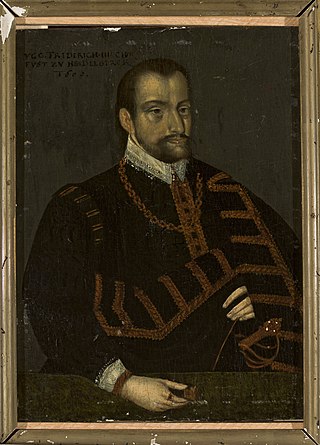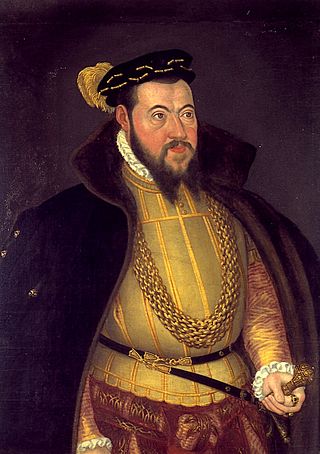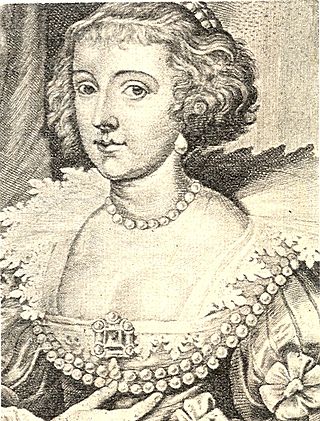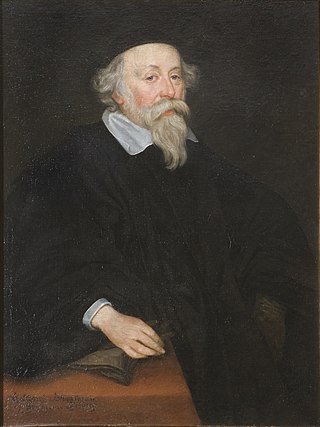Pfalz, Pfälzer, or Pfälzisch are German words referring to Palatinate.

John Casimir, Count Palatine of Simmern was a German prince and a younger son of Frederick III, Elector Palatine. A firm Calvinist, he was a leader of mercenary troops in the religious wars of the time, including the Dutch Revolt. From 1583–1592 he acted as regent for his nephew, Elector Palatine Frederick IV.

Catherine of Sweden was a Swedish princess and a Countess Palatine of Zweibrücken as the consort of her second cousin John Casimir of Palatinate-Zweibrücken. She is known as the periodical foster-mother of Queen Christina of Sweden and the mother of Charles X of Sweden.

Frederick IV, Elector Palatine of the Rhine, only surviving son of Louis VI, Elector Palatine and Elisabeth of Hesse, called "Frederick the Righteous".

Frederick III of Simmern, the Pious, Elector Palatine of the Rhine was a ruler from the house of Wittelsbach, branch Palatinate-Simmern-Sponheim. He was a son of John II of Simmern and inherited the Palatinate from the childless Elector Otto-Henry, Elector Palatine (Ottheinrich) in 1559. He was a devout convert to Calvinism, and made the Reformed confession the official religion of his domain by overseeing the composition and promulgation of the Heidelberg Catechism. His support of Calvinism gave the German Reformed movement a foothold within the Holy Roman Empire.
Palatinate or county palatine may refer to:

Stephen of Simmern-Zweibrücken was Count Palatine of Simmern and Zweibrücken from 1410 until his death in 1459.

The House of Palatinate-Simmern was a German-Bavarian cadet branch of the House of Wittelsbach. The house was one of the collateral lineages of the Palatinate. It became the main branch in 1559.

The Duchy of Palatinate-Zweibrücken was a duchy of the Holy Roman Empire with full voting rights to the Reichstag. Its capital was Zweibrücken. The reigning house, a branch of the Wittelsbach dynasty, was also the Royal House of Sweden from 1654 to 1720.

The County Palatine of Veldenz was a principality in the contemporary Land Rhineland-Palatinate with full voting rights to the Reichstag. The county was located partially between Kaiserslautern, Sponheim and Zweibrücken, partially on the Mosel in the Archbishopric of Trier. A municipality of the same name, Veldenz, and a castle, Schloss Veldenz, are located in the district of Bernkastel-Wittlich.

Count Palatine Wolfgang of Zweibrücken was member of the Wittelsbach family of the Counts Palatine and Duke of Zweibrücken from 1532. With the support of his regent, his uncle Rupert, Wolfgang introduced the Reformation to Zweibrücken in 1537.

John I of Zweibrücken was Count Palatine and Duke of Zweibrücken during 1569–1604.

Obermoschel is a town and municipality in the district Donnersbergkreis, Rhineland-Palatinate, Germany. With around 1,000 residents, it is the smallest town in the Palatinate (Pfalz). It is part of the Verbandsgemeinde Nordpfälzer Land, which has its seat of administration in community of Rockenhausen and an administrative office in Alsenz. According to regional planning, Obermoschel is designated as lower-order center (Grundzentrum).

Louis VI, Elector Palatine, was an Elector from the Palatinate-Simmern branch of the house of Wittelsbach. He was the first-born son of Frederick III, Elector Palatine and Marie of Brandenburg-Kulmbach.

Frederick Casimir was the Duke of Landsberg from 1604 until 1645.

Frederick Louis was the Duke of Landsberg from 1645 until 1681, and the Count Palatine of Zweibrücken from 1661 until 1681.

Countess Emilia Antwerpiana of Nassau was the sixth and youngest daughter of William the Silent and his third wife, Charlotte of Bourbon.

John Casimir, Count Palatine of Zweibrücken-Kleeburg was the son of John I, Count Palatine of Zweibrücken and his wife, Duchess Magdalene of Jülich-Cleves-Berg. He was married to Catherine of Sweden and was the founder of a branch of Wittelsbach Counts Palatine often called the Swedish line, because it gave rise to three subsequent kings of Sweden, but more commonly known as the Kleeburg line.
Palatinate-Simmern and Zweibrücken was a state of the Holy Roman Empire based in the Simmern and Zweibrücken in modern Rhineland-Palatinate, Germany.

Duchess Magdalene of Jülich-Cleves-Berg was the fifth child of Duke William "the Rich" of Jülich-Cleves-Berg and Maria of Austria, a daughter of Emperor Ferdinand I.